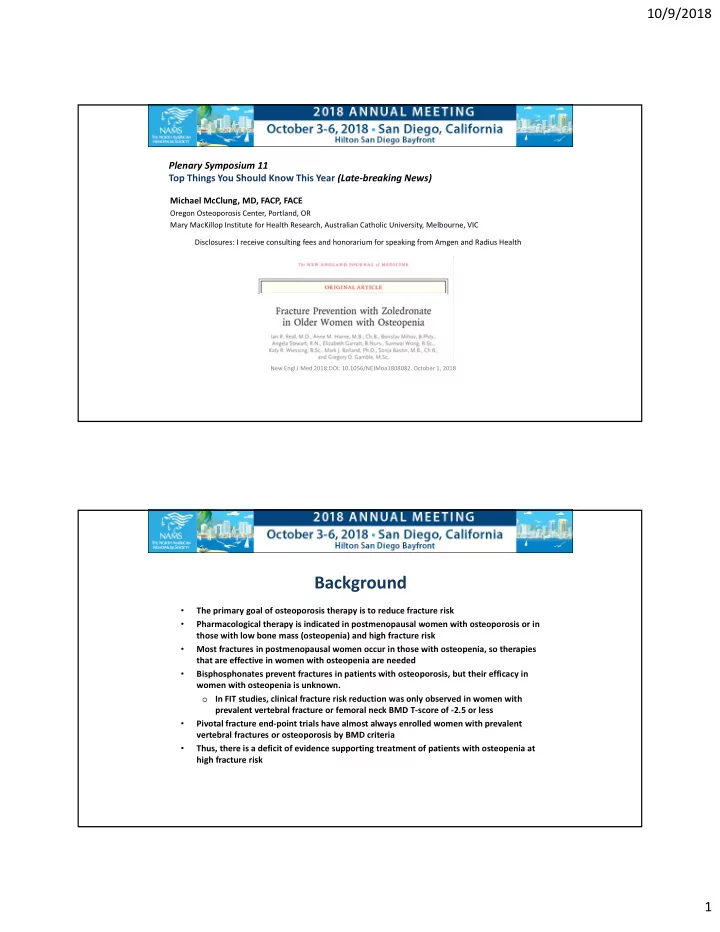

10/9/2018 Plenary Symposium 11 Top Things You Should Know This Year (Late ‐ breaking News) Michael McClung, MD, FACP, FACE Oregon Osteoporosis Center, Portland, OR Mary MacKillop Institute for Health Research, Australian Catholic University, Melbourne, VIC Disclosures: I receive consulting fees and honorarium for speaking from Amgen and Radius Health New Engl J Med 2018:DOI: 10.1056/NEJMoa1808082. October 1, 2018 Background The primary goal of osteoporosis therapy is to reduce fracture risk • Pharmacological therapy is indicated in postmenopausal women with osteoporosis or in • those with low bone mass (osteopenia) and high fracture risk Most fractures in postmenopausal women occur in those with osteopenia, so therapies • that are effective in women with osteopenia are needed Bisphosphonates prevent fractures in patients with osteoporosis, but their efficacy in • women with osteopenia is unknown. In FIT studies, clinical fracture risk reduction was only observed in women with o prevalent vertebral fracture or femoral neck BMD T ‐ score of ‐ 2.5 or less Pivotal fracture end ‐ point trials have almost always enrolled women with prevalent • vertebral fractures or osteoporosis by BMD criteria Thus, there is a deficit of evidence supporting treatment of patients with osteopenia at • high fracture risk 1
10/9/2018 Aim and Methods Objective: to evaluate the effect of intravenous zoledronic acid therapy to reduce fracture • risk in women aged 65 and older with osteopenia Methods: Randomized, double ‐ blind, placebo ‐ controlled trial • 2000 postmenopausal women age 65 and older with osteopenia (T ‐ score between ‐ 1 and ‐ • 2.5) at the femoral neck or total hip on either side Randomly assigned to receive IV zoledronic acid or placebo Q 18 months for 6 years. – All received vitamin D supplements 50,000 IU D3/month – Calcium supplements were not given – Primary endpoint: Time to first occurrence of a fragility fracture • non ‐ vertebral fracture (excluding fractures of the toes, metatarsals, fingers, metacarpals, skull, face – and mandible) vertebral fractures confirmed by X ‐ rays taken with acute onset of back pain and at year 3 and 6 – Results Placebo Zoledronic acid Baseline characteristics N = 1000 N = 1000 Completed 6 years: 925 Completed 6 years: 936 Plus–minus values are means ±SD Age, years (mean ± SD) 71±5.1 71±5.0 Dietary calcium intake ‐ mg per day 882±388 871±360 History of nonvertebral fracture after age 45 ‐ no. (%) 238 (23.8) 237 (23.7) Prevalent vertebral fracture (Grade 2 or 3) ‐ no. (%) 126 (12.6) 137 (13.7) Median 10 ‐ year risk of osteoporotic fracture ‐ % (IQR) 12 (9–15) 12 (9–16) Median 10 ‐ year risk of hip fracture ‐ % (IQR) 2.3 (1.5–3.8) 2.4 (1.5–3.9) BMD T ‐ score Lumbar spine − 0.87±1.16 − 0.91±1.12 Total hip − 1.24±0.60 − 1.27±0.59 Femoral neck − 1.63±0.47 − 1.64±0.47 2
10/9/2018 Results Fracture type % reduction (CI) Plus–minus values are means ±SD. Fragility fracture 37% (21, 50)* Vertebral fracture 55% (27, 73)* Non ‐ vertebral fracture 34% (15, 49)* Hip fracture 34% ( ‐ 16, 73) Wrist 44% (15, 63)* Excluding the 163 women with osteoporosis by BMD criteria did not affect hazard ratio or its significance Relative risk reductions were not affected by baseline age, calcium intake, BMD, fracture status or fracture risk Adverse event % reduction (CI) Death 35% ( ‐ 3, 60) Myocardial infarction 39% ( ‐ 2, 64) Stroke 15% ( ‐ 37, 56) Cancer 33% (11, 50)* No ONJ or atypical fractures occurred * = statistically significant Impact and Significance of Study This study provides important evidence that osteoporosis treatment reduces • fracture risk in older postmenopausal women at risk for fracture but who do not meet the criteria for osteoporosis, justifying the treatment guidelines. These results are not an endorsement for pharmacological treatment of all women • with osteopenia – only those with other important risk factors for fracture. 1 There is no reason to think that these results are unique to zoledronic acid – and • they likely pertain to other potent anti ‐ remodeling agents such as alendronate and denosumab which significantly reduce fractures in women at modest risk of fracture. 2 The latter reduces vertebral fracture risk in women on aromatase inhibitors who have normal BMD. 3 1. McClung M. Osteopenia: To treat or not to treat. Ann Intern Med 2005;142:796 ‐ 7 2. McCloskey EV et al. Denosumab reduces the risk of osteoporotic fractures in postmenopausal women, particularly in those with moderate to high fracture risk as assessed with FRAX. J Bone Miner Res 2012;27:1480 ‐ 6 3. Gnant M et al. Adjuvant denosumab in breast cancer (ABCSG ‐ 18): a multicentre, randomised, double ‐ blind, placebo ‐ controlled trial. Lancet 2015;386:433 ‐ 43 3
Recommend
More recommend